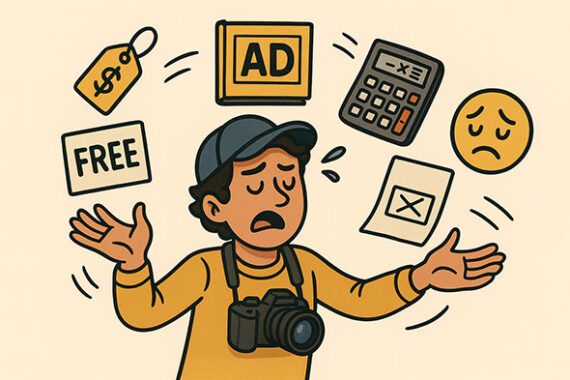As something of an interesting experiment, I asked my Twitter followers to answer this question:
“What are the top business errors by ‘rookie’ photographers?”
Within just a few minutes I had several great responses, and thought they would make a great article. See below.

It’s one thing to be a great photographer, but very much another to be the owner of a successful photography business. In fact, I’ve seen far too many technically talented photographers suffer through difficult times, while observing others who seem less qualified sail right on by.
The main difference in these two outcomes lies in the photographer’s understanding of the importance of business knowledge.
You’re a photography business owner—not a photographer.
As I’ve said on plenty of previous occasions, it’s not the most talented photographer who wins, but the best marketer and business-minded photographer.
What, then, are the six most common mistakes, at least according to my Twitter followers?
Here they are, in no particular order:
1. Undercharging For Their Time And Talent
This is a huge mistake that many newbies make, usually because they join the industry as a serious amateur who’s found the potential for earning money practicing what they already like to do. Not that there is anything wrong with amateurs turning professional—far from it.
The trouble is, most of them fail to realize that the moment they charge for their work, they’ve moved from amateur to professional. That shift also requires a change in thinking, especially when it comes to how they view the value of their photography.
If photographers would just stop at this point to examine the situation, and fully understand the implications of being a professional, I think the industry would have a lot fewer problems.
All it needs is a simple change in perspective—from amateur photographer to serious studio owner.
As a business owner, one of the first responsibilities is to fully realize the cost of keeping the business open and what it costs just to pick up the camera for a job.
With these factors in mind, together with a realistic valuation of the photographer’s time, added to the actual cost of sales of products sold, the photographer can calculate healthy prices that correctly value their work and time.
2. Mistakes With Paid Advertising
I made the very same mistake when I started in business, much to my disappointment (and an empty bank account)! The advertising in question was the “Yellow Pages”, and I believe I watched almost $3,600 disappear into thin air as a result. At the time, I didn’t know any better, and thought I needed to be in the Yellow Pages just because that’s what was expected. Besides, there were lots of other photographers in there, so it must be the proper thing to do, right?
Nope.
Other mistakes I made with paid advertising included certain Internet directories and paid listings, none of which provided any leads—let alone clients.
If you’re a recently new photographer, and you’re considering paid advertising, then it pays to really take into account the target market of the advertising, how effective the reach is, the experiences of other photographers who have taken part in it, etc. If you’re in any doubt, don’t do it!
3. Setting Prices Without Knowing Their COGS
This was alluded to in #1, but it’s worth mentioning again here. Knowing your COGS (cost of goods sold) is absolutely critical to producing a price list that will sustain a healthy business. COGS includes all the direct costs necessary for making a sale, but not fixed costs such as internet, telephone, rent, etc.
The one thing a lot of photographers omit from their COGS is their time, which is a huge mistake. Your time is your second most valuable asset (your attitude being number one), and you need to charge for it, even if it’s only a small hourly rate.
Having determined the COGS for any given service, it’s good practice to mark that up at least three times to produce a final retail price.
This is the point at which so many photographers get scared and descend into the vicious cycle of constantly tinkering with their price list—especially if they’re having a hard time with sales.
4. Not Following a Business Plan
To begin with, rookie photographers don’t often spend much time to create a business plan and then work the plan.
Do YOU have a business plan? An actual written plan that provides a frame of reference for your studio, defines your goals, and acts as a roadmap for success?
I’m willing to wager that the vast majority of photographers don’t possess such a document. Often, this is because they don’t like the job, don’t know how to write one, are too busy, or lack clearly defined ideas about their goals.
Whatever the reason, if your business was an airplane, it would not have much chance of reaching its destination without a flight plan, would it?
A business plan need not be complicated! It’s only for you—to keep you on track—so it doesn’t have to be produced as though you’re a major corporation.
Simplicity means clarity—and the greater the chance you’ll adhere to it!
5. Working For Free
This is an interesting one, and encompasses a subject I see quite often in the many online photography groups: the idea of photographing for free (or almost free) in the hopes of gaining exposure.
You can’t be in the photography business for very long without someone asking you to photograph something (often an event of some kind) for a very low rate on the promise it will give you great exposure or the prospect of more, higher-paid work down the line.
This is an insult to the photographer, and it does a lot of damage to the photography industry. The promised “exposure” more often than not turns out to be non-existent, and further work usually entails poor compensation at best.
Consider the concepts presented in items #1 and #3 when making your decision about these types of jobs, and you can’t go too far wrong.
My advice to new photographers is to not fall into the trap of imagining that just because you’re not experienced in the business that you can’t ask for what you and your photography are worth.
6. Imagining That It’s Easy
I expect that most photographers working today will probably admit that they thought it would be easier than it turned out to be! Myself included!
The truth is, running a professional photography studio is not easy. Running any business is difficult—I don’t care what it is. There certainly are no “get rich fast” business plans for photographers!
Perhaps the “easy” idea comes more from the photography side of things. After all, that part is a lot of fun, and we can be technically very good at it; it’s what we’re here to do, right?
Unfortunately, the clicking of the shutter only takes up 20 percent of our business efforts, and that’s being generous! The other 80 percent is taken up by marketing, selling, social media, accounting, planning, studying, marketing (so exciting it’s worth mentioning twice!), etc.
Those business-related jobs are probably those we became photographers in order to avoid, but get out of them we can’t! They are all essential and vital to our success, so we may as well get used to them.
What Would Be Your #7 Top Mistake?
Thank you to the Twitter followers who contributed to this research, and I do plan to try this experiment again sometime.
These are only six of the errors that many of us fall into, and I’m quite sure there are many more!
What other blunders would you add to the list? What would be your #7 mistake to warn rookie professional photographers about?
About the Author:
Nigel Merrick is a professional photographer, blogger and business coach for other working photographers. Nigel’s helps professional photographers find peace in their business, love from their clients, and happiness in their personal lives by clarifying their focus on business and marketing.
Like This Article?
Don't Miss The Next One!
Join over 100,000 photographers of all experience levels who receive our free photography tips and articles to stay current:






Jack Ligon is 100% right about the showing unedited photos to client.
I am going to take a bit of an exception to #4, using COGS to set pricing.
Pricing should be set based on value to the customer and not a business’ cost structure. A customer doesn’t care about your costs. They just want to get their money’s worth in the product they receive.
If your COGS based pricing is greater than the perceived value, you will get little to no business. If your COGS based pricing is lower than the customer’s perceived value, then you, as a business owner, are leaving money on the table.
To increase your pricing, increase the value of your photographs, not your costs.
Of course, the viability of the photography business will be determined by the difference between costs and pricing (or more properly expenses and income).
With that, you must understand and take into account all tangible and intangible costs which the article touches upon.
These are great tips – I know I’m guilty of a few of them! Thanks!
Not necessarily a mistake, but I think it helps to identify the client base(s) you wish to serve and factor that into your marketing.
great article.. wise tips from responses as well.. I’m not offering a suggestion for #7 as I myself remain a student of the buisness of photography.thank you all for valuable insight,an willingness to share.
Jack Ligon’s post stood out the most as recently I’ve a fellow photographer friend seeking to be getting a foothold and he mentioned thats exactly what he does- and even as far as posts them on line..
School of Hard Knocks!! is for some the only way they’ll learn.. :/
as another photographer I know – had a deep sence of aarogance,after seeing images produced from his vision, I gladly suggested a psychologist..
so those two represent a scale.. one one side there is a great passion an humble heart ( to humble,as posts all photos ) // an other side is aarogance.. an to me I’d rather see a million blury photos than one photo from an arrogant person..someone with strong aarogance,I will never address as a photographer-regardless !!- photography is about the vision of life an creation cycle..photographing anothers aarogance is a complete different subject,,projecting self imagery is idolatry when spewed forth from the mouth of an aarogant person.. — ok, sorry,, kinda went off on that one.:} -stepping off my soap box now — Next !! —
(most from personal experience)
Not meeting their own deadlines
Spending too much of the money that is earned (and not investing it back into the business)
Discounting their products/fees every other week (reducing their value and profit margin)
Not reading their camera manual
Not having a lawyer make REAL contracts
Not having contracts for assistants/employees
Not paying taxes properly
Not properly keeping records of finances
Not showing their best work online
cant agree more. Ive recently started my business and realised that people want more for less money.. ! One gets tempted to take up such opportunities to get the “experience”, but does cause a lot of damage!
I am totally guilty of #1. The question I have, is where to find those industry standard figures.
In the research I’ve done, there is such a large range of prices and ways that professionals are charging these days (especially with the digital revolution), that I don’t know what is fair anymore.
Some charge way too much (imo) and others barely anything… I don’t know where I fit into that.
Does anyone know of a reference site that gives lists of standards? Or any info helpful in this area?
A quick thanks for posting this article here, it’s great to see it being used to help other photographers in the business, and nice to see some insightful comments as well.
All the best to you and thanks again!
Nigel
As an amateur photographer with no intention of going professional, I have hired professional photographers for family occasions where I wish to not play photographer. I think the #1 mistake a professional photographer can make is not being professional.
When setting a price, stick to it (or discount it if you didn’t meet commitments for numbers of photos taken), but don’t try to up it later. Arrive on time. Return telephone calls. Have a pleasant attitude. Dress appropriately. Don’t swear. Have clearly defined payment options. Present photographs professionally. Pay attention to presentation of fliers, stationery and other business items. All things clients expect when they deal with a business, but I thought I’d point it out anyway. :-)
not getting everything agreed upon in writing.
Your article was total on track. I’ve been a photographer for 30 years and have been teaching photography and a class on How to Make $$$ in Photography for 6 years. A thought on what number seven could be… It should be obvious yet I’ve seen newbies show ALL of the pictures of their shoot to the clients and even more surprising without editing them. Number seven should be learn how to present your work. I would think the last could be an article in itself.
Just in time, as I am thinking of taking my photography to pro :)
Great points and lots of stuff to think about.
Thank you.
Mojca
Not registering your images wtih the US Copyright Office.